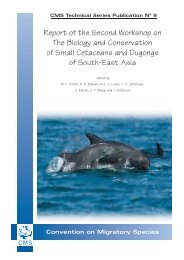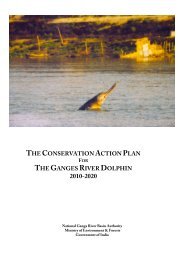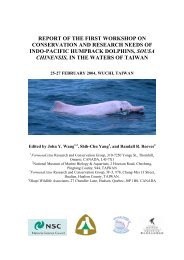Dolphins, Whales and Porpoises: 2002-2010 Conservation - IUCN
Dolphins, Whales and Porpoises: 2002-2010 Conservation - IUCN
Dolphins, Whales and Porpoises: 2002-2010 Conservation - IUCN
You also want an ePaper? Increase the reach of your titles
YUMPU automatically turns print PDFs into web optimized ePapers that Google loves.
around the world. There are estimated to be some 150,000 in<br />
the eastern tropical Pacific (Wade <strong>and</strong> Gerrodette 1993) <strong>and</strong><br />
about 850 in the northern Gulf of Mexico (Waring et al.<br />
2001). Rough-toothed dolphins are notorious for stealing<br />
bait <strong>and</strong> catch from fishing lines, making them unpopular<br />
with many recreational <strong>and</strong> commercial fishermen.<br />
Common bottlenose dolphin, Tursiops<br />
truncatus<br />
The common bottlenose dolphin occurs in all tropical <strong>and</strong><br />
temperate waters, including the littoral zone, inshore lagoons,<br />
estuaries, <strong>and</strong> bays, <strong>and</strong> the offshore realm (Wells<br />
<strong>and</strong> Scott 1999; Reynolds et al. 2000). In some areas where<br />
the species has been studied closely, offshore animals are<br />
distinguishable from coastal animals on the basis of morphology<br />
<strong>and</strong> ecological markers (e.g., Mead <strong>and</strong> Potter 1995).<br />
Moreover, the two forms in the North Atlantic have fixed<br />
genetic differences <strong>and</strong>, therefore, eventually may be assigned<br />
to different species (Leduc <strong>and</strong> Curry 1997; Hoelzel<br />
et al. 1998). Coastal <strong>and</strong> isl<strong>and</strong>-centered populations are<br />
especially vulnerable to hunting, incidental catch, <strong>and</strong> habitat<br />
degradation (Curry <strong>and</strong> Smith 1997 for a review).<br />
Acute conservation problems are known or suspected in at<br />
least: (a) the Mediterranean <strong>and</strong> Black seas, where past<br />
hunting, incidental catches, <strong>and</strong> environmental degradation<br />
have caused population declines (IWC 1992); (b) Sri Lanka,<br />
where this is one of the principal species taken by harpoon<br />
<strong>and</strong> gillnet for fishbait <strong>and</strong> human food (Leatherwood <strong>and</strong><br />
Reeves 1989); (c) Peru (<strong>and</strong> possibly Chile), where both<br />
directed (mainly the inshore form) <strong>and</strong> incidental (mainly<br />
the offshore form) killing occurs (Read et al. 1988; Van<br />
Waerebeek et al. 1990; K. Van Waerebeek, pers. comm.);<br />
(d) Taiwan, where there was a recent drive <strong>and</strong> harpoon<br />
fishery on the Penghu Isl<strong>and</strong>s (Hammond <strong>and</strong> Leatherwood<br />
1984; Perrin 1988) <strong>and</strong> where exploitation for meat on the<br />
east coast apparently continues (Wang et al. 1999); <strong>and</strong> (e)<br />
Japan, where large numbers (e.g., nearly 3400 in 1980) have<br />
been taken in some years in the drive <strong>and</strong> harpoon fisheries<br />
(Miyazaki 1983) <strong>and</strong> where more than 4000 were culled for<br />
fishery protection at Iki Isl<strong>and</strong> from 1977 to 1982 (Kasuya<br />
1985). The culling off northern Kyushu has declined in<br />
recent years, but the take in drive <strong>and</strong> h<strong>and</strong>-harpoon fisheries<br />
along the Pacific coast has increased since the early<br />
1980s (IWC 1992; Kishiro <strong>and</strong> Kasuya 1993). Tens of<br />
bottlenose dolphins are killed in some years in pilot whale<br />
drives in the Faroe Isl<strong>and</strong>s. On the east coast of the United<br />
States <strong>and</strong> in the northern Gulf of Mexico, large-scale dieoffs<br />
of bottlenose dolphins have occurred, but the causes are<br />
not fully understood (Geraci et al. 1999).<br />
The common bottlenose dolphin is the species most often<br />
held in captivity; hence, problems concerning the welfare of<br />
cetaceans in captivity often center on it. Unregulated livecapture<br />
fisheries can contribute to the depletion of wild<br />
populations. A regime is in place for managing live-capture<br />
operations in the south-eastern United States (Scott 1990),<br />
but captures in Cuba, mainl<strong>and</strong> Latin America, <strong>and</strong> elsewhere<br />
are poorly documented <strong>and</strong> often unregulated<br />
(Chapter 5, Project 38).<br />
Indo-Pacific bottlenose dolphin,<br />
Tursiops aduncus<br />
This coastal, mainly tropical <strong>and</strong> subtropical species has<br />
only recently been accorded full species status. Much of the<br />
literature on bottlenose dolphins (including Reeves <strong>and</strong><br />
Leatherwood 1994a) makes no distinction between the common<br />
<strong>and</strong> Indo-Pacific species. The Indo-Pacific bottlenose<br />
dolphin is known from southern Japan southward to<br />
Australia <strong>and</strong> along the entire rim of the Indian Ocean<br />
(including the Indo-Malay archipelago) to Cape Agulhas in<br />
south-eastern Africa, including the Red Sea. Although not<br />
considered to be endangered as a species, its very near-shore<br />
distribution makes this dolphin vulnerable to environmental<br />
degradation, direct exploitation, <strong>and</strong> fishery conflicts (Curry<br />
<strong>and</strong> Smith 1997; Wells <strong>and</strong> Scott 1999). In the recent past,<br />
large numbers were killed in a Taiwanese drive fishery. Although<br />
this deliberate killing is now prohibited in Taiwan,<br />
gillnet mortality continues to be a problem there <strong>and</strong><br />
throughout most of the species’ range. Large numbers of<br />
Indo-Pacific bottlenose dolphins died in a Taiwanese<br />
driftnet fishery in the Arafura Sea, off north-western<br />
Australia, during the early 1980s (Harwood <strong>and</strong> Hembree<br />
1987). In South Africa <strong>and</strong> Australia, Indo-Pacific bottlenose<br />
dolphins also suffer considerable mortality in the<br />
large-mesh nets set to protect bathers from sharks (cf.<br />
Peddemors 1999). As a preferred species in captive displays,<br />
there is substantial, <strong>and</strong> growing, dem<strong>and</strong> for this dolphin<br />
in the exp<strong>and</strong>ing oceanarium trade throughout southern<br />
Asia (Wang et al. 1999).<br />
4.6 Monodontids<br />
White whale or Beluga,<br />
Delphinapterus leucas<br />
This circumpolar species was formerly abundant throughout<br />
the Arctic <strong>and</strong> Subarctic. There may still be in the order of<br />
150,000 white whales in total (IWC 2000a; NAMMCO<br />
2000b), but many of the 29 stocks provisionally recognized<br />
by the IWC Scientific Committee have been seriously reduced<br />
by hunting. Even these depleted populations continue<br />
to be hunted <strong>and</strong> are therefore at risk of being extirpated.<br />
They include the belugas in Cook Inlet, Alaska (c.350<br />
individuals); Ungava Bay, Canada (





